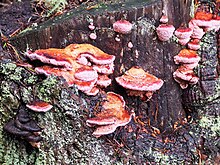| Rhodofomes cajanderi | |
|---|---|

| |
| Scientific classification | |
| Domain: | Eukaryota |
| Kingdom: | Fungi |
| Division: | Basidiomycota |
| Class: | Agaricomycetes |
| Order: | Polyporales |
| Genus: | Rhodofomes |
| Species: | R. cajanderi |
| Binomial name | |
| Rhodofomes cajanderi (P.Karst.) B.K. Cui, M.L. Han & Y.C. Dai (2016) | |
| Synonyms | |
List
| |
Rhodofomes cajanderi is a widely distributed species of bracket fungus. Commonly known as the rosy conk due to its rose-colored pore surface, it causes a disease called a brown pocket rot in various conifer species. It is inedible. It is widespread in western North America, with more prevalence in southern climates. It has a particular preference for higher-altitude spruce forests.
Identification
Rhodofomes cajanderi is a perennial shelf fungus. It may be identified by its small-to-medium-sized, fleshy, tough fruit-body, with a downy or crust-like top. It grows to around 3–10 cm (1.2–3.9 in) wide. The top surface is a pink colour becoming to grey, brown, or black, with a clear margin. The inside of the conk and the bottom are a rosy pink colour. The body of the fungus is rigid and can grow up to 1 cm thick. There are 3–5 round pores per millimeter.
This species of polypore is morphologically similar to its relative, Rhodofomes roseus. Other similar species include Fomitopsis pinicola, Ganoderma lucidum, Ganoderma oregonense, and Rhodonia placenta.
See also
References
- ^ Ginns, J. H. (James Herbert) (2017). Polypores of British Columbia (Fungi: Basidiomycota). Victoria, BC. ISBN 978-0-7726-7053-3. OCLC 982126526.
{{cite book}}: CS1 maint: location missing publisher (link) - Phillips, Roger (2010). Mushrooms and Other Fungi of North America. Buffalo, NY: Firefly Books. p. 309. ISBN 978-1-55407-651-2.
- Watling, Roy. (1973). Identification of the larger fungi. Amersham: Hulton. ISBN 0-7175-0595-2. OCLC 1200490.
- ^ Davis, R. Michael; Sommer, Robert; Menge, John A. (2012). Field Guide to Mushrooms of Western North America. Berkeley: University of California Press. pp. 346–347. ISBN 978-0-520-95360-4. OCLC 797915861.
| Taxon identifiers | |
|---|---|
| Rhodofomes cajanderi | |
| Fomitopsis cajanderi | |
| Fomes cajanderi | |
This Polyporales-related article is a stub. You can help Misplaced Pages by expanding it. |